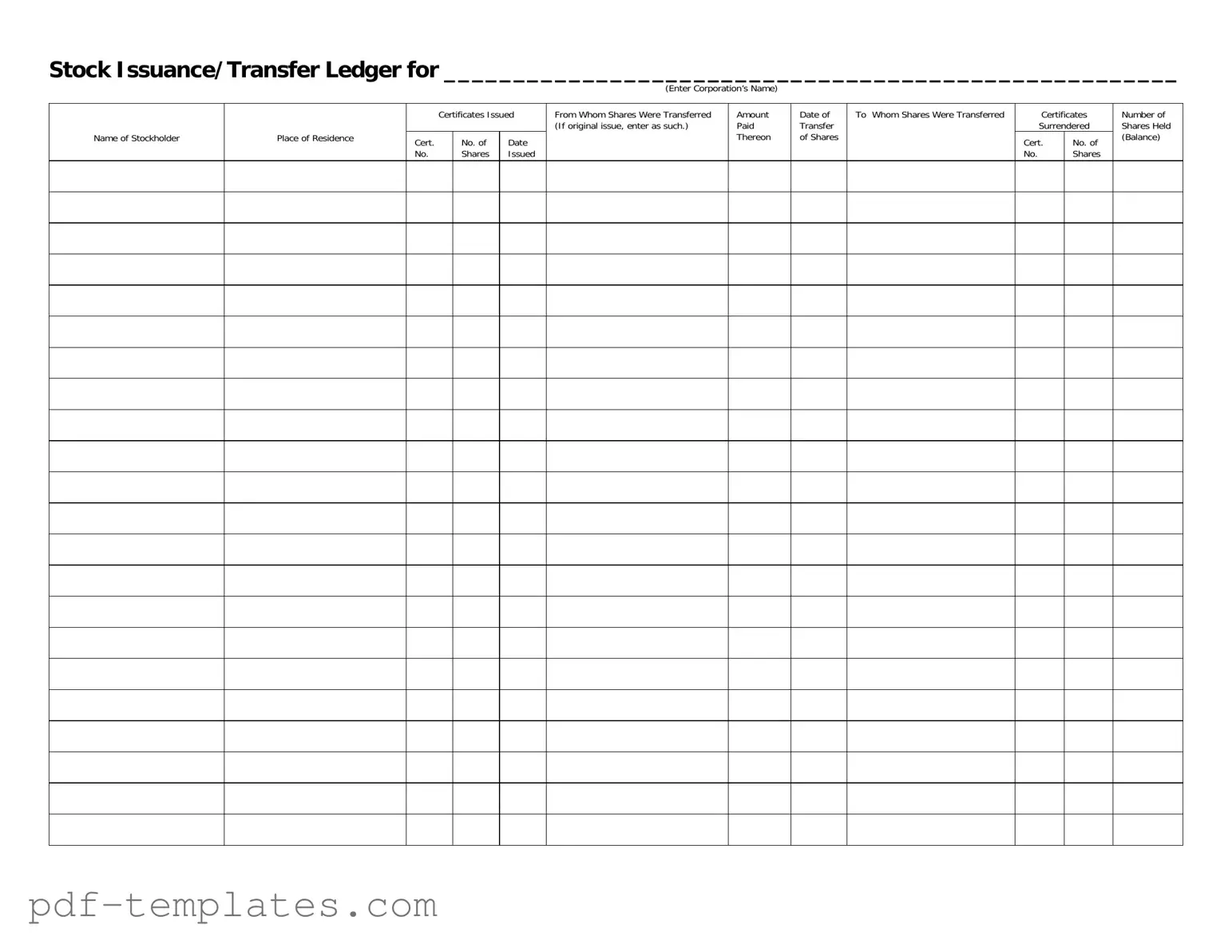The Stock Transfer Ledger form bears similarities to the Shareholder Register. This document lists all the shareholders of a corporation, detailing their names, addresses, and the number of shares owned. Like the Stock Transfer Ledger, it tracks ownership, ensuring that the corporation maintains accurate records of who holds shares at any given time. Both documents serve the purpose of documenting changes in ownership and are crucial for maintaining transparency within the corporation.
Another document akin to the Stock Transfer Ledger is the Stock Certificate. This physical document represents ownership of a specific number of shares in a corporation. It includes details such as the shareholder's name, the number of shares, and the certificate number. While the Stock Transfer Ledger records transactions and changes in ownership, the Stock Certificate serves as proof of ownership, making both essential in the management of corporate shares.
The Corporate Bylaws also share similarities with the Stock Transfer Ledger. Bylaws outline the rules and procedures for the governance of a corporation, including how stock transfers should be handled. They establish the framework within which the Stock Transfer Ledger operates, ensuring that all transfers are conducted according to the corporation's established policies and legal requirements.
The Minutes of Shareholder Meetings are another related document. These minutes capture the decisions made during shareholder meetings, including any votes on stock transfers or issuances. Like the Stock Transfer Ledger, they help maintain a clear record of corporate actions and shareholder intentions, providing context for changes in stock ownership.
The Stock Option Agreement is similar as well. This document outlines the terms under which stock options are granted to employees or other stakeholders. While the Stock Transfer Ledger records the actual transfer of shares, the Stock Option Agreement details the rights to purchase shares, thus influencing future entries in the ledger as options are exercised and shares are transferred.
The Purchase Agreement for Shares is another document that aligns with the Stock Transfer Ledger. This agreement specifies the terms under which shares are bought and sold between parties. It includes details such as the number of shares, price, and conditions of the sale. Once the agreement is executed, the transfer of shares is recorded in the Stock Transfer Ledger, linking the two documents closely.
The Securities and Exchange Commission (SEC) Filings are also comparable. Corporations are required to submit various filings to the SEC, including reports of stock issuances and transfers. These filings provide a broader context for the data recorded in the Stock Transfer Ledger, ensuring compliance with federal regulations and offering transparency to investors and the public.
The Dividend Distribution Record can be viewed as similar as well. This document tracks the distribution of dividends to shareholders based on their ownership stakes. While the Stock Transfer Ledger focuses on ownership changes, the Dividend Distribution Record ensures that shareholders receive their rightful dividends, reflecting the financial benefits of their ownership in the corporation.
When dealing with complex financial documentation, understanding the various forms that record stock ownership is crucial. For instance, a Mechanics Lien California form is essential for contractors and suppliers asserting their rights to payment, similar to how a Shareholder Register tracks ownership in a corporation. To ensure compliance and clarity in such financial matters, referring to All California Forms can provide invaluable guidance.
Lastly, the Transfer Agent Records are comparable to the Stock Transfer Ledger. A transfer agent manages the transfer of shares and maintains accurate records of stock ownership. They work closely with the Stock Transfer Ledger to ensure that all transactions are properly recorded and that shareholders receive their stock certificates and dividends in a timely manner.
